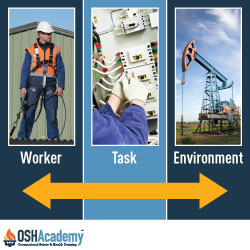Risk Factors Inherent in the Task
In addition to considering the worker attributes that may increase the risk of injury, we must also analyze the risk factors the work task itself brings to the job.
We look at the task variables in the workplace that may increase or decrease the risk of cumulative trauma disorders (CTDs) depending on its design and location.
In large measure, the following risk factors influence the probability and severity of ergonomic injuries when completing work processes:
- Force: Forcefulness is the amount of physical effort required by the person to do a task and/or maintain control of tools and equipment.
- Vibration: The duration of exposure to vibration. There are two basic types of vibration that can result in MSDs: segmental vibration and whole body vibration.
- Repetition: Repetition is a measure of how frequently we complete the same motion or exertion during a task.
- Recovery time: Recovery time is a measure of the rest period available to the muscle group between similar exertions.
- Duration: Duration is a measure of the length of time of exposure to a risk factor.
- Twisting: Twisting in the middle of a lift greatly amplifies the forces on the lower back.
- Posture: Posture is the position of the body while performing work activities.
Knowledge Check Choose the best answer for the question.
3-1. Which risk factor inherent in the task greatly amplifies the forces on the lower back?
You forgot to answer the question!

